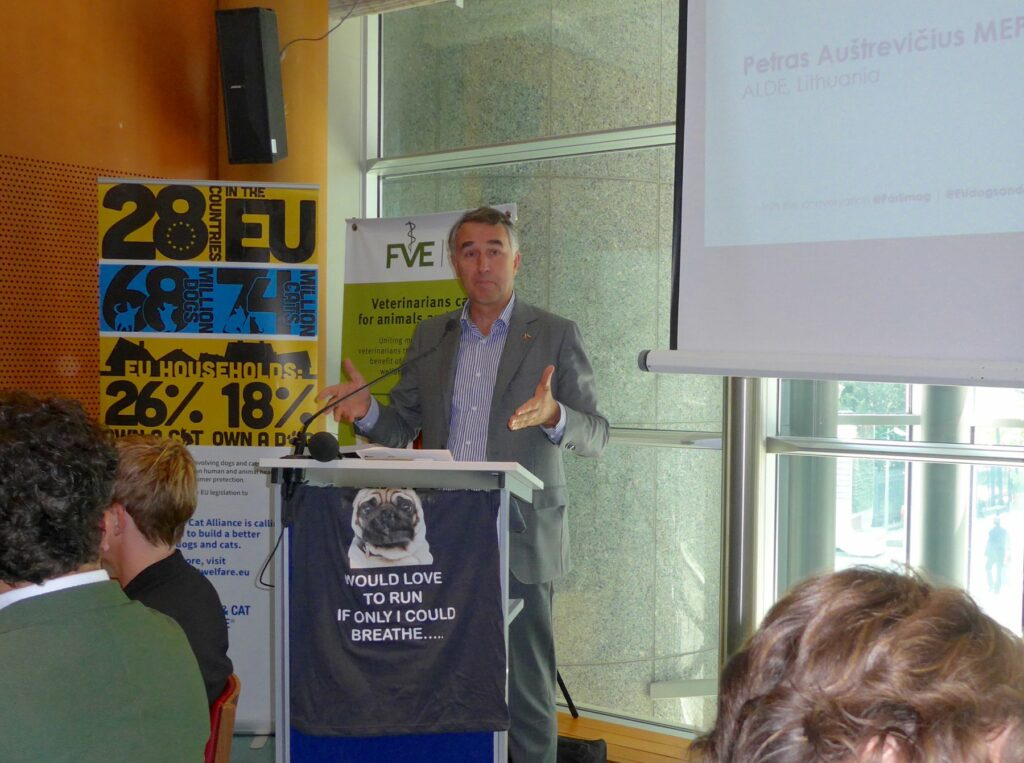
Raising public awareness is key. Extreme breeding and how to tackle it was the topic of the discussion held at the European Parliament in Brussels on 26 June.
Hosted by Members of the European Parliament Petras Austrevicius and Marlene Mizzi, and jointly organised the Federation of Companion Animal Veterinary Associations (FECAVA), the Federation of Veterinarians of Europe (FVE) and the EU Cat and Dog Alliance, it was the occasion for different stakeholders to share their viewpoints and suggest a way forward. ‘The engineering of animals needs to be addressed before it becomes more disgraceful than it already is,’ urged Marlene Mizzi MEP, addressing participants via a video message. ‘Animals have rights and dignity and deserve our respect.’
‘Extreme breeding is the selection of animals for a particular look to the point of animal suffering,’ explained Monique Megens, representing FECAVA. She gave the example of brachycephalic animals that had ‘too much tissue’ in their shortened heads so that they were struggling to breathe. But also other genetic features such as folded ears, sloping backs and hairlessness were causing animal suffering. She announced that the Federation of Veterinarians of Europe and FECAVA had recently adopted a joint veterinary position paper on breeding healthy dogs . ‘Health and welfare should go before looks,’ she urged.
‘By definition, selection and improvement is opposed to genetic variation,’ explained Kristin Prestrud of the Norwegian kennel club. ‘This means only limited selection is possible with today’s system of closed stud books. In shows, the ‘ideal’ is that all same-breed dogs should preferably look alike.’ Over time, many breeds have become more exaggerated than their original version: ‘short legs have become shorter, heavy bodies heavier, long ears longer and so on. This is not how it was meant to be originally. Where is the limit for functional anatomy?’ While for some features, limits had been set, they still need to be clarified for others. She went on to explain that in Nordic countries, so-called breed-specific instructions (BSI) are used to ensure show winners have a functional anatomy.
Catherine Dobbie of Dog’s Trust said that there were many ‘cute’ videos online of dogs snoring, struggling to walk and showing other behaviour that was actually a result of extreme breeding. ‘Advertising, films and social media promoting such dogs could fuel the demand and increase the so-called pester power.’ She added that owners often then wanted such a dog immediately, without considering the health, welfare or the origin of such animals. ‘Of the puppies seized as part of the Dogs Trust Puppy Pilot , 6% sadly died due to poor health, malnutrition and dehydration. Unscrupulous dealers in the puppy trade can make large amounts of money with little risk compared to activities such as drug smuggling,’ she said.
‘We must prevent extremes in any form,’ agreed Rony Doedijns, from the Dutch Kennel Club. He presented ‘fair breeding’, a multi-stakeholder programme set up by the Dutch government. The programme includes education of breeders, judges, behaviourists and veterinarians; animal health and welfare regulations for all pedigree dogs, breed-specific regulation including fitness tests for breeds like bulldogs. It also included a ‘spot the differences’ campaign to promote ‘Dutch bred’ pedigrees. He also added that only 25% of the Dutch dog population were pedigree dogs and that the breeding associations had no impact on lookalikes bred outside the system – or even abroad.
Petra Sindern, of the German Veterinary Practitioners’ Association (bpt) outlined the initiatives taken against ‘torture breeding’ in her country, such as a campaign to raise awareness among dog owners and letters asking advertisers to refrain from using dogs that are a result of extreme-breeding. She also highlighted the collaboration between state veterinary officers and practitioners. ‘Official vets can check animal breeders and sanction them if the animals are not healthy. They can send the animals to a specialist veterinarian for assessment.’
Gudrun Ravetz of the British Veterinary Association called for better enforcement and stricter sanctions. ‘Any initiative we take should be meaningful, evidence-based, enforceable and enforced and, most importantly: people should know about it.’ As an example, she said that the Kennel club and the veterinary profession had set up a joint database to report corrective surgery and caesarean sections in pedigreed. However, she found that only 3% of vets were reporting this. ‘Submitting data through practice data sharing programmes such as Compass or SAVSnet will allow to see what’s happening across the entire dog population, providing the evidence we need.’
During the discussion, it became clear that raising public awareness is key. Some suggested to find ways to make these animals less ‘fashionable’, e.g. by promoting ‘normal’ dogs and by educating the public on what a healthy dog should look like. It was also suggested to adopt breed-specific instructions for show judges, to involve veterinarians and veterinary associations in setting healthy breed standards and to open up stud books to improve the gene pool.
All participants agreed that extreme breeding was a serious issue, which had reached excesses in recent years, compromising animal welfare and needed urgent action. Stakeholders should collaborate to ensure dogs and cats were bred on the basis that ‘health and welfare go before looks’.
Notes for Editors
• The Federation of European Companion Animal Veterinary Associations (www.fecava.org) is the platform for the promotion of the professional development and representation of companion animal veterinarians in Europe. Founded in 1990, it currently has 40 national member associations and 13 associate member associations. FECAVA represents over 25,000 companion animal practitioners throughout Europe.
Contact: Karin de Lange kdelange@invivo.edu, +33 2 99 07 87 10
• The Federation of Veterinarians of Europe (www.fve.org) is an umbrella organisation of 44 veterinary organisations from 38 European countries, representing a total of around 240 000 veterinarians. The Federation of Veterinarians of Europe (FVE) strives to promote animal health, animal welfare and public health across Europe.
Contact: FVE Secretariat info@fve.org, +32 2 533 70 20